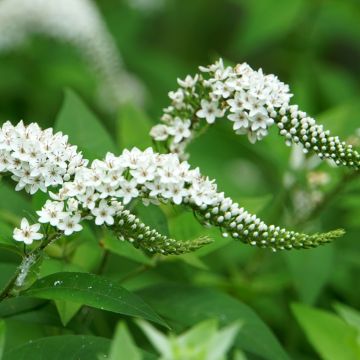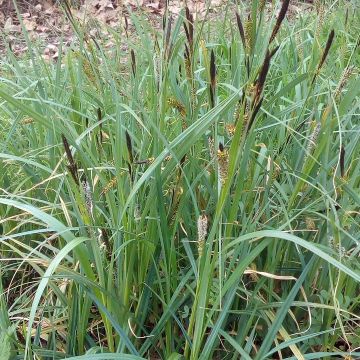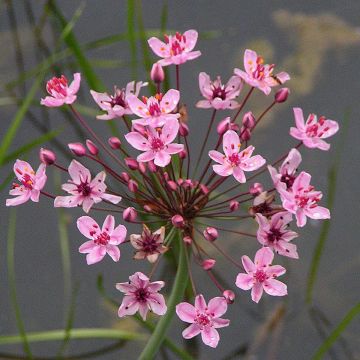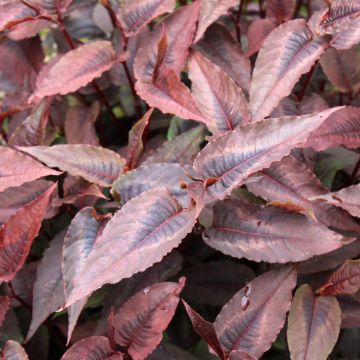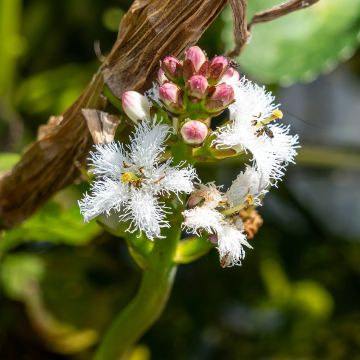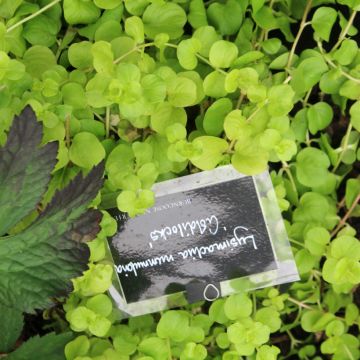

Orontium aquaticum
Orontium aquaticum
Orontium aquaticum
Golden Club, Bog Torch
This item cannot be shipped to the selected country
Delivery charge from €5.90
More information
Schedule delivery date,
and select date in basket
This plant carries a 12 months recovery warranty
More information
We guarantee the quality of our plants for a full growing cycle, and will replace at our expense any plant that fails to recover under normal climatic and planting conditions.
From €5.90 for pickup delivery and €6.90 for home delivery
Express home delivery from €8.90.
Does this plant fit my garden?
Set up your Plantfit profile →
Description
The genus Orontium comprises a single species, Orontium aquaticum, also known as Goldenclub, Aquatic Orontium, or Candle Plant. It is a perennial aquatic plant with an exotic appearance, belonging to the family Araceae. It has large spatulate leaves that can be submerged, floating, or emergent. The summer flowering consists of elongated spikes with bright yellow colour, resembling a candle or a candlestick. This is a truly unique plant, perfect for solitary cultivation.
Orontium aquaticum belongs to the Araceae family. It is native to the eastern United States, along the coast, in ponds, marshes, and shallow streams with low flow. It is a rosette-forming perennial plant that reaches a height of 40cm (16in) when in flower, with a spread of 60cm (24in). Its growth is relatively slow, and it often takes several years to achieve abundant flowering. This plant has leathery, waxy, simple lance-shaped leaves, measuring 25cm (10in) in length. They are acidic green when young, turning metallic bluish-green with a purple underside. The reddish petioles, shaped like a gouge at the base, can reach up to 40cm (16in) in length. The floral spikes, which bloom in summer, have a short lifespan. The parchment-like spathe is negligible and quickly withers, but the bright yellow spadix, measuring 15cm (6in) in length, stands out on a long stem. The rhizomes are thick, reddish, fleshy, and deeply rooted in the mud.
The Aquatic Goldenclub can withstand winter in a pond or basin, as long as it is submerged under at least 15cm (6in) of water to prevent freezing, but not deeper than 45cm (18in). It prefers a clayey and highly fertile soil. It is best to plant it in spring, after the frost has passed. Its foliage looks best in full sun or morning shade. Not invasive, it is preferable to place it in a space or pot (or basket) where it can remain, ideally in the mud at the bottom, as it does not like to be moved. Remove faded floral spikes as they appear.
The Candle Plant will be particularly striking in a large submerged container, with its base kept frost-free. It does not tolerate competition from other pond plants. It is best to reserve a clear spot for it, such as by waterfalls or in containers. It also thrives on muddy banks, along the edges of ponds, basins, marshes, and streams.
Its root was once consumed, cooked in multiple waters to remove the Calcium Oxalate crystals contained in its tissues. Its seeds, similar to small brownish-orange peas, underwent the same treatment and are said to be delicious.
Report an error about the product description
Orontium aquaticum in pictures


Flowering
Foliage
Plant habit
Botanical data
Orontium
aquaticum
Aceraceae
Golden Club, Bog Torch
North America
Other Aquatic plants
Planting and care
The aquatic Orontium can survive the winter in a pond or basin, under a minimum of 15cm (6in) of water to avoid freezing, but not deeper than 45cm (18in), in clayey and highly fertile soil. Plant it preferably in spring, after the frost has passed. The foliage looks best in the sun or morning shade. Never invasive, it is preferable to place it in a space or pot (or basket) where it can remain, if necessary in the mud at the bottom, as it does not like to be moved. Remove faded spikes as they appear.
Planting period
Intended location
Care
-
, onOrder confirmed
Reply from on Promesse de fleurs
Haven't found what you were looking for?
Hardiness is the lowest winter temperature a plant can endure without suffering serious damage or even dying. However, hardiness is affected by location (a sheltered area, such as a patio), protection (winter cover) and soil type (hardiness is improved by well-drained soil).

Photo Sharing Terms & Conditions
In order to encourage gardeners to interact and share their experiences, Promesse de fleurs offers various media enabling content to be uploaded onto its Site - in particular via the ‘Photo sharing’ module.
The User agrees to refrain from:
- Posting any content that is illegal, prejudicial, insulting, racist, inciteful to hatred, revisionist, contrary to public decency, that infringes on privacy or on the privacy rights of third parties, in particular the publicity rights of persons and goods, intellectual property rights, or the right to privacy.
- Submitting content on behalf of a third party;
- Impersonate the identity of a third party and/or publish any personal information about a third party;
In general, the User undertakes to refrain from any unethical behaviour.
All Content (in particular text, comments, files, images, photos, videos, creative works, etc.), which may be subject to property or intellectual property rights, image or other private rights, shall remain the property of the User, subject to the limited rights granted by the terms of the licence granted by Promesse de fleurs as stated below. Users are at liberty to publish or not to publish such Content on the Site, notably via the ‘Photo Sharing’ facility, and accept that this Content shall be made public and freely accessible, notably on the Internet.
Users further acknowledge, undertake to have ,and guarantee that they hold all necessary rights and permissions to publish such material on the Site, in particular with regard to the legislation in force pertaining to any privacy, property, intellectual property, image, or contractual rights, or rights of any other nature. By publishing such Content on the Site, Users acknowledge accepting full liability as publishers of the Content within the meaning of the law, and grant Promesse de fleurs, free of charge, an inclusive, worldwide licence for the said Content for the entire duration of its publication, including all reproduction, representation, up/downloading, displaying, performing, transmission, and storage rights.
Users also grant permission for their name to be linked to the Content and accept that this link may not always be made available.
By engaging in posting material, Users consent to their Content becoming automatically accessible on the Internet, in particular on other sites and/or blogs and/or web pages of the Promesse de fleurs site, including in particular social pages and the Promesse de fleurs catalogue.
Users may secure the removal of entrusted content free of charge by issuing a simple request via our contact form.
The flowering period indicated on our website applies to countries and regions located in USDA zone 8 (France, the United Kingdom, Ireland, the Netherlands, etc.)
It will vary according to where you live:
- In zones 9 to 10 (Italy, Spain, Greece, etc.), flowering will occur about 2 to 4 weeks earlier.
- In zones 6 to 7 (Germany, Poland, Slovenia, and lower mountainous regions), flowering will be delayed by 2 to 3 weeks.
- In zone 5 (Central Europe, Scandinavia), blooming will be delayed by 3 to 5 weeks.
In temperate climates, pruning of spring-flowering shrubs (forsythia, spireas, etc.) should be done just after flowering.
Pruning of summer-flowering shrubs (Indian Lilac, Perovskia, etc.) can be done in winter or spring.
In cold regions as well as with frost-sensitive plants, avoid pruning too early when severe frosts may still occur.
The planting period indicated on our website applies to countries and regions located in USDA zone 8 (France, United Kingdom, Ireland, Netherlands).
It will vary according to where you live:
- In Mediterranean zones (Marseille, Madrid, Milan, etc.), autumn and winter are the best planting periods.
- In continental zones (Strasbourg, Munich, Vienna, etc.), delay planting by 2 to 3 weeks in spring and bring it forward by 2 to 4 weeks in autumn.
- In mountainous regions (the Alps, Pyrenees, Carpathians, etc.), it is best to plant in late spring (May-June) or late summer (August-September).
The harvesting period indicated on our website applies to countries and regions in USDA zone 8 (France, England, Ireland, the Netherlands).
In colder areas (Scandinavia, Poland, Austria...) fruit and vegetable harvests are likely to be delayed by 3-4 weeks.
In warmer areas (Italy, Spain, Greece, etc.), harvesting will probably take place earlier, depending on weather conditions.
The sowing periods indicated on our website apply to countries and regions within USDA Zone 8 (France, UK, Ireland, Netherlands).
In colder areas (Scandinavia, Poland, Austria...), delay any outdoor sowing by 3-4 weeks, or sow under glass.
In warmer climes (Italy, Spain, Greece, etc.), bring outdoor sowing forward by a few weeks.

































